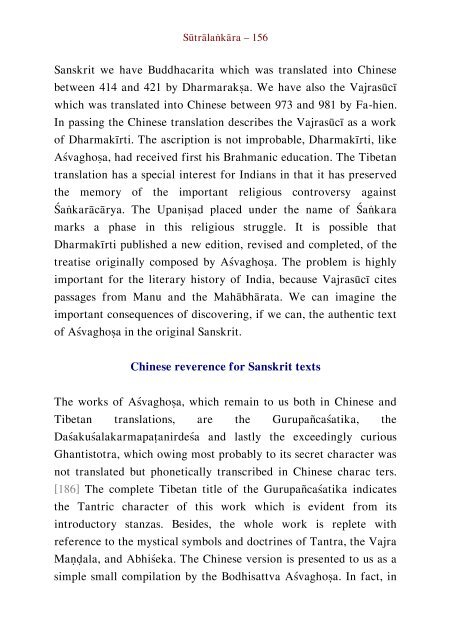Literary History of Sanskrit Buddhism
A study by J. K. Nariman of Sanskrit Buddhism from the Early Buddhist Tradition up to the Mahayana texts proper.
A study by J. K. Nariman of Sanskrit Buddhism from the Early Buddhist Tradition up to the Mahayana texts proper.
You also want an ePaper? Increase the reach of your titles
YUMPU automatically turns print PDFs into web optimized ePapers that Google loves.
Sūtrālaṅkāra – 156<br />
<strong>Sanskrit</strong> we have Buddhacarita which was translated into Chinese<br />
between 414 and 421 by Dharmarakṣa. We have also the Vajrasūcī<br />
which was translated into Chinese between 973 and 981 by Fa-hien.<br />
In passing the Chinese translation describes the Vajrasūcī as a work<br />
<strong>of</strong> Dharmakīrti. The ascription is not improbable, Dharmakīrti, like<br />
Aśvaghoṣa, had received first his Brahmanic education. The Tibetan<br />
translation has a special interest for Indians in that it has preserved<br />
the memory <strong>of</strong> the important religious controversy against<br />
Śaṅkarācārya. The Upaniṣad placed under the name <strong>of</strong> Śaṅkara<br />
marks a phase in this religious struggle. It is possible that<br />
Dharmakīrti published a new edition, revised and completed, <strong>of</strong> the<br />
treatise originally composed by Aśvaghoṣa. The problem is highly<br />
important for the literary history <strong>of</strong> India, because Vajrasūcī cites<br />
passages from Manu and the Mahābhārata. We can imagine the<br />
important consequences <strong>of</strong> discovering, if we can, the authentic text<br />
<strong>of</strong> Aśvaghoṣa in the original <strong>Sanskrit</strong>.<br />
Chinese reverence for <strong>Sanskrit</strong> texts<br />
The works <strong>of</strong> Aśvaghoṣa, which remain to us both in Chinese and<br />
Tibetan translations, are the Gurupañcaśatika, the<br />
Daśakuśalakarmapaṭanirdeśa and lastly the exceedingly curious<br />
Ghantistotra, which owing most probably to its secret character was<br />
not translated but phonetically transcribed in Chinese charac ters.<br />
[186] The complete Tibetan title <strong>of</strong> the Gurupañcaśatika indicates<br />
the Tantric character <strong>of</strong> this work which is evident from its<br />
introductory stanzas. Besides, the whole work is replete with<br />
reference to the mystical symbols and doctrines <strong>of</strong> Tantra, the Vajra<br />
Maṇḍala, and Abhiśeka. The Chinese version is presented to us as a<br />
simple small compilation by the Bodhisattva Aśvaghoṣa. In fact, in


















